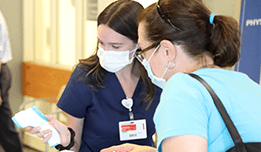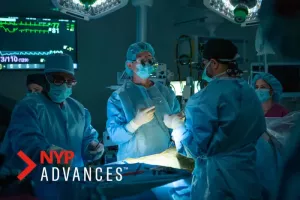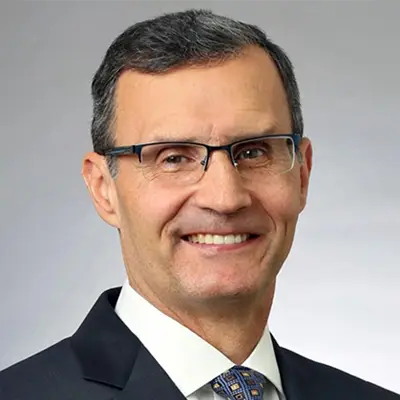Congenital kyphoscoliosis is a rare spinal deformity that causes the spine to curve both forward and sideways. Since the condition creates compression of the spinal cord and the surrounding organs, it also comes with significant neurological risks and can create difficulty breathing. For 16-year-old Chinno Villena, his case was so severe that surgeons couldn’t distinguish his vertebrae on a basic X-ray.
After struggling with optimal care in the Philippines, in 2019, a family member saw a news story featuring Lawrence Lenke, MD, co-director of Och Spine at NewYork-Presbyterian and chief of spinal deformity surgery at NewYork-Presbyterian and Columbia. Chinno’s mom was determined to bring her son to see Dr. Lenke for care and moved their family 9,000 miles to the U.S. for his treatment.
Below, Dr. Lenke shares details of the staged spinal reconstruction surgery, Chinno’s recovery, and what his future prognosis and quality of life is expected to look like.
Less than 1% of patients with congenital kyphoscoliosis have the degree of severity and complexity of Chinno’s condition.
— Dr. Lawrence Lenke
How the Patient Presented
I first met Chinno in 2023 when he was 16 years old. He was diagnosed with congenital kyphoscoliosis at birth and the condition worsened over the years. When he was seven, surgeons in the Philippines attempted a spinal fusion but the procedure was not successful in realigning the curvature of his spine. Bracing was suggested but was not an option due to his severe truncal deformity.

X-rays from March 2024 show the severe fixed congenital curve – with 140 degrees kyphosis and 56 degrees scoliosis.
By the time he came to see me, he hadn’t received any additional treatment. Upon examination, it was very apparent that he had a severe fixed congenital curve – with 140 degrees kyphosis and 56 degrees scoliosis. Less than 1% of patients with congenital kyphoscoliosis have the degree of severity and complexity of Chinno’s condition. On average, I see these type of cases once or twice a month in my practice, which is high and due to the level of complex care provided by my practice to both children and adults with spinal deformity.
There were several factors that made Chinno’s treatment complicated. First, every single vertebra in his spine was abnormal. Additionally, his entire spine, except for the lowest level L5-S1, was completely fused and even when he was laying down there was no postural correction. Finally, he was out of balance, with his trunk leaning both to the left and forward. These factors created a challenging surgical situation with a greater risk of neurologic complications as well.
The potential benefits of surgery outweighed those risks, so we moved forward with a staged treatment plan. To assist us in planning the procedures, we created a 3D printed model of Chinno’s entire spine that we used to study his aberrant anatomy before and during the surgeries to help us anticipate any surgical issues.
Six Weeks, Multiple Procedures
Because of the complexity of Chinno’s case, we created a staged plan of carefully scheduled procedures to gradually correct the kyphoscoliosis. I worked with Thomas Zervos, MD, an advanced pediatric spinal deformity fellow at Columbia, to begin Chinno’s treatment in April 2024 using halo gravity traction, where we pinned a halo to Chinno’s skull and slowly added weight to safely stretch his spine and spinal cord in preparation for surgery. He was in traction for four weeks and tolerated it very well.

X-rays nine weeks after Chinno’s surgery show his kyphosis and scoliosis significantly improved.
After he completed traction, we performed three additional procedures in May 2024 to loosen his spine, gradually correct the curvature, and fuse it into its proper position. In his second procedure, we performed a rib resection and installation of a cage at the lumbosacral joint at the L5-S1 level. The third procedure involved the placement of rods and screws from T2 to the sacrum, the removal of four vertebrae (T8, T9, T10, and T11 vertebra) to separate the spine into 2 sections and realign it for correction, and the placement of bone material to help fuse the spine. His final procedure entailed irrigation and debridement of the wound to provide more efficient wound healing.
In your mid-teens, your skeleton is mature, but your spinal cord is still somewhat pliable, making the neurological risks less than when this type of surgery is performed in middle-age and older adults.
— Dr. Lawrence Lenke
Prognosis
Despite the complex nature of the surgery, Chinno came to us at the ideal time. In your mid-teens, your skeleton is mature, but your spinal cord is still somewhat pliable, making the neurological risks less than when this type of surgery is performed in middle-age and older adults. The procedures were successful, and he is healing well.

Chinno before and after the staged treatment to gradually correct the curvature and fuse his spine into its proper position.
Right now, we are waiting for his spine to fully fuse over the next year. For patients’ his age, typically there isn’t much formal therapy or rehabilitation involved in recovery – we allow the body to heal on its own from the extensive surgeries while progressing his activities as he tolerates. We will see him back at one-year postoperative mark and if he is doing well, we will release him to full activities without limitations, whether that is driving a car or going skiing.
Lessons Learned
I learned a lot from the persistence and positivity of Chinno and his mother. She waited years to make the move to the U.S. and to come to Och Spine at NewYork-Presbyterian and Columbia for this surgery. At their initial visit, when his mother told me about the time, energy, and sacrifice she and her family had undergone to bring Chinno to us for his care, I was extremely moved by her tremendous dedication to her son and his resiliency.

Chinno and Dr. Lenke after complete spinal reconstructive surgery to correct severe congenital kyphoscoliosis.
Chinno dealt with being away from home, friends, and family, undergoing a series of pretty scary surgeries and basically living in the hospital for nearly two months. But despite it all, his attitude was tremendously upbeat, and he was a favorite around the hospital. I was very honored to care for him and I look forward to watching his recovery and return to a normal life.




